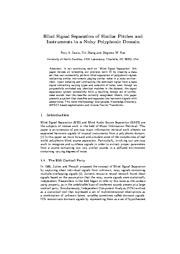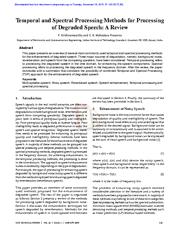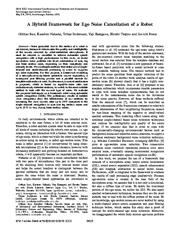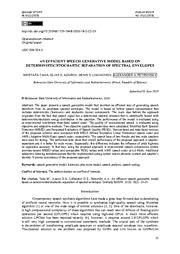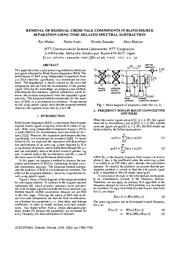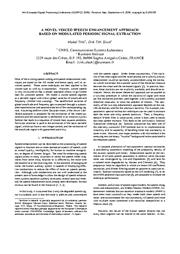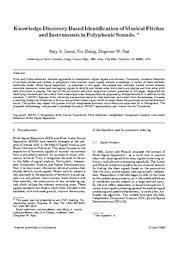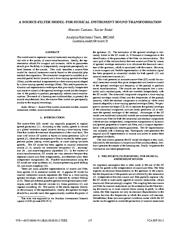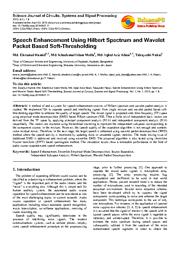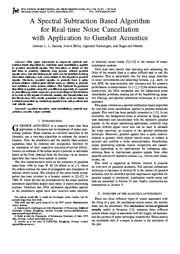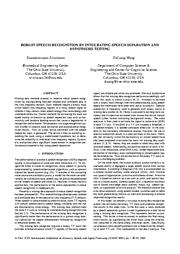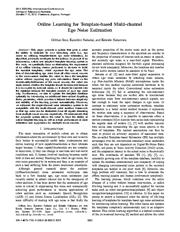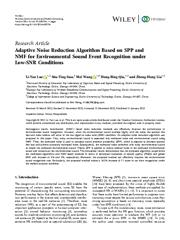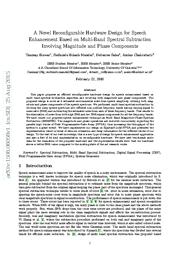A copy of this work was available on the public web and has been preserved in the Wayback Machine. The capture dates from 2007; you can also visit the original URL.
The file type is application/pdf.
Filters
Blind Signal Separation of Similar Pitches and Instruments in a Noisy Polyphonic Domain
[chapter]
2006
Lecture Notes in Computer Science
In our continuing work on "Blind Signal Separation" this paper focuses on extending our previous work [1] by creating a data set that can successfully perform blind separation of polyphonic signals containing ...
Upon isolating and subtracting the dominant signal from a base signal containing varying types and amounts of noise, even though we purposefully excluded any identical matches in the dataset, the signal ...
Acknowledgements This research is supported by the National Science Foundation under grant IIS-0414815. ...
doi:10.1007/11875604_26
fatcat:7o67ijhwfnhrpftokuhchi2tmy
Temporal and Spectral Processing Methods for Processing of Degraded Speech: A Review
2009
IETE Technical Review
Three major sources of degradation, namely, background noise, reverberation and speech from the competing speakers, have been considered. ...
This paper presents an overview of several most commonly used temporal and spectral processing methods for the enhancement of degraded speech. ...
Spectral subtraction is performed by subtracting the average magnitude of the noise spectrum from the spectrum of the noisy speech, to estimate the magnitude of the enhanced speech spectrum [1]. ...
doi:10.4103/0256-4602.49103
fatcat:5b5n4y73srb2nfg7gdgobxaruq
A hybrid framework for ego noise cancellation of a robot
2010
2010 IEEE International Conference on Robotics and Automation
For this purpose, a framework consisting of a microphone-array-based geometric source separation, a consequent post filtering process and a parallel module for template subtraction is used. ...
Furthermore, a control mechanism is proposed, which is based on signal-to-noise ratio and instantaneously detected motions, to switch to the most suitable method to deal with the current type of noise. ...
This module is based on the optimal estimator proposed by Ephraim and Malah [16] . ...
doi:10.1109/robot.2010.5509564
dblp:conf/icra/InceNRHTI10
fatcat:h4r5y32uszfz3mru5kuup3xudm
AN EFFICIENT SPEECH GENERATIVE MODEL BASED ON DETERMINISTIC/STOCHASTIC SEPARATION OF SPECTRAL ENVELOPES
2020
Doklady BGUIR
The model is based on hybrid speech representation that includes deterministic (harmonic) and stochastic (noise) components. ...
Supposedly, this difference indicates the influence of pitch highness on separation accuracy. ...
Instantaneous harmonic parameters are calculated using the technique based on analysis filters [3] . Filter bands are recalculated for each frame of the signal using estimated pitch values. ...
doi:10.35596/1729-7648-2020-18-2-23-29
doaj:4adc279fa7e84b8c958f4681c74eb7a0
fatcat:njb4xbqyenfttebhid2jarlxmu
Removal of residual cross-talk components in Blind Source Separation using time-delayed spectral subtraction
2002
IEEE International Conference on Acoustics Speech and Signal Processing
This paper describes a post processing method to refine output signals obtained by Blind Source Separation (BSS). ...
Utilizing this knowledge, we propose a new method, time-delayed non-stationary spectral subtraction, which removes the residual components from the separated signals precisely. ...
In contrast to the original spectral subtraction [6] , which assumes stationary noise and periods with no target signal to estimate the noise spectrum, our method requires neither assumption, because ...
doi:10.1109/icassp.2002.5744970
dblp:conf/icassp/MukaiASM02
fatcat:xudr5qt7dbe2dlip7rughb64km
Removal of residual crosstalk components in blind source separation using time-delayed spectral subtraction
2002
IEEE International Conference on Acoustics Speech and Signal Processing
This paper describes a post processing method to refine output signals obtained by Blind Source Separation (BSS). ...
Utilizing this knowledge, we propose a new method, time-delayed non-stationary spectral subtraction, which removes the residual components from the separated signals precisely. ...
In contrast to the original spectral subtraction [6] , which assumes stationary noise and periods with no target signal to estimate the noise spectrum, our method requires neither assumption, because ...
doi:10.1109/icassp.2002.1006111
fatcat:b5i2mihpt5hilnmgzxydbr42cq
A Novel Voiced Speech Enhancement Approach Based On Modulated Periodic Signal Extraction
2006
Zenodo
Publication in the conference proceedings of EUSIPCO, Florence, Italy, 2006 ...
A tractable alternative of non-parametric spectral estimation is provided by parametric modeling of the probability density of the sources (speech and noise). ...
The tracking of the noise spectrum can be performed, also, on voiced frames (using the noise estimate Ú Ý ×). ...
doi:10.5281/zenodo.52987
fatcat:j2fi64gd7nb7vjq5j4yflu3nvq
Knowledge discovery-based identification of musical pitches and instruments in polyphonic sounds
2007
Engineering applications of artificial intelligence
The part of the instrument and pitch recognition system, presented in this paper, responsible for identifying the dominant instrument from a base signal uses temporal features proposed by Wieczorkowska ...
A review of these methods, sometimes called "Blind Signal Separation", is presented in this paper. ...
Acknowledgements This work is supported by the National Science Foundation under grant IIS-0414815. ...
doi:10.1016/j.engappai.2006.11.006
fatcat:hvjxq5ux4fctrbo5b6gfdrz2gm
A source-filter model for musical instrument sound transformation
2012
2012 IEEE International Conference on Acoustics, Speech and Signal Processing (ICASSP)
This work describes a source-filter model for musical instrument sounds based on the sinusoidal plus residual decomposition. ...
The sinusoidal component is modeled as sinusoidal partial tracks (source) and a time-varying spectral envelope (filter), and the residual is represented as white noise (source) shaped by a time-varying ...
Signal Processing Modeling of Source and Filter The musical instrument sound y (t) is separated into a sinusoidal component ys (t) plus a residual component yr (t) where yr (t) is obtained by subtraction ...
doi:10.1109/icassp.2012.6287836
dblp:conf/icassp/CaetanoR12
fatcat:shvtbkof5jbb3hz6biuszuw4y4
Speech Enhancement Using Hilbert Spectrum and Wavelet Packet Based Soft-Thresholding
2015
Science Journal of Circuits Systems and Signal Processing
However, the speech quality of the separation algorithm is not enough and contains some residual noises. ...
The simulation results show a noticeable performance in the field of audio source separation and speech enhancement. ...
Acknowledgement We would like to thank to National Institute of Information and Communications Technology (NICT) for providing support to carry out the study. ...
doi:10.11648/j.cssp.20150401.12
fatcat:wolamdkktfgtra643u7fyl4eea
A Spectral Subtraction Based Algorithm for Real-time Noise Cancellation with Application to Gunshot Acoustics
2013
International Journal of Electronics and Telecommunications
This paper introduces an improved spectral subtraction based algorithm for real-time noise cancellation, applied to gunshot acoustical signals. ...
The results presented in this work are based on a dataset generated by combining signals from real gunshots and real vehicle noise. ...
In the sniper positioning application, relatively long periods without signal occur and can be used to estimate the noise spectrum, as required in the spectral subtraction technique. ...
doi:10.2478/eletel-2013-0011
fatcat:wnyshx6qr5dhlcuk2gqno6au6y
Robust speech recognition by integrating speech separation and hypothesis testing
2010
Speech Communication
Current methods for estimating the mask are based mainly on bottom-up speech separation cues such as harmonicity and produce labeling errors that cause a degradation in recognition performance. ...
The lattice is then re-scored by expanding the mask using a model-based hypothesis test to determine the reliability of individual time-frequency regions. ...
This research was supported in part by an AFOSR grant (FA9550-04-1-0117) and an NSF grant (IIS-0081058). We thank J. Barker for help with the speech fragment decoder. ...
doi:10.1016/j.specom.2009.08.008
fatcat:tntp3afhnrhfjj3ahzqznjhyca
Online learning for template-based multi-channel ego noise estimation
2012
2012 IEEE/RSJ International Conference on Intelligent Robots and Systems
Based on the directionality/diffuseness of the sound sources, the robot can easily decide whether the template should be discarded because it is corrupted by external noises, or it should be inserted into ...
This paper presents a system that gives a robot the ability to diminish its own disturbing noise (i.e., ego noise) by utilizing template-based ego noise estimation, an algorithm previously developed by ...
By doing so, spectral subtraction is applied on the spectrum of each individual sound source using its corresponding ego noise spectrum. (Fig. 3(a) ). ...
doi:10.1109/iros.2012.6385824
dblp:conf/iros/InceNN12
fatcat:quhvof4dcbgkrcjoh4r6mdqm2e
Adaptive Noise Reduction Algorithm Based on SPP and NMF for Environmental Sound Event Recognition under Low-SNR Conditions
2023
Wireless Communications and Mobile Computing
An adaptive noise reduction algorithm was proposed in this paper. First, noisy environmental sound is separated into estimated noise and environmental sound using NMF. ...
Then, the estimated noise is used to calculate sound presence probability (SPP), which is adapted to decrease spectral line loss and achieve accurately estimated noise. ...
The NMF-Based NR Technique NMF is a technique of source separation to additive mixtures by using the basis matrix. ...
doi:10.1155/2023/6582296
fatcat:5bmlxz3wgzc53mflgq2jieoblq
A Novel Reconfigurable Hardware Design for Speech Enhancement Based on Multi-Band Spectral Subtraction Involving Magnitude and Phase Components
[article]
2015
arXiv
pre-print
We performed multi-band spectrum subtraction by dividing the noisy speech spectrum into different non-uniform frequency bands having varying signal to noise ratio (SNR) and subtracting the estimated noise ...
This paper proposes an efficient reconfigurable hardware design for speech enhancement based on multi band spectral subtraction algorithm and involving both magnitude and phase components. ...
Acknowledgment This work has been supported by the University Grant Commission (UGC) RGNF-2012-13-SC-WES-26014, Govt of India. ...
arXiv:1508.06056v1
fatcat:ktr6czyslbbhfbyy3oom57ji6a
« Previous
Showing results 1 — 15 out of 5,179 results

